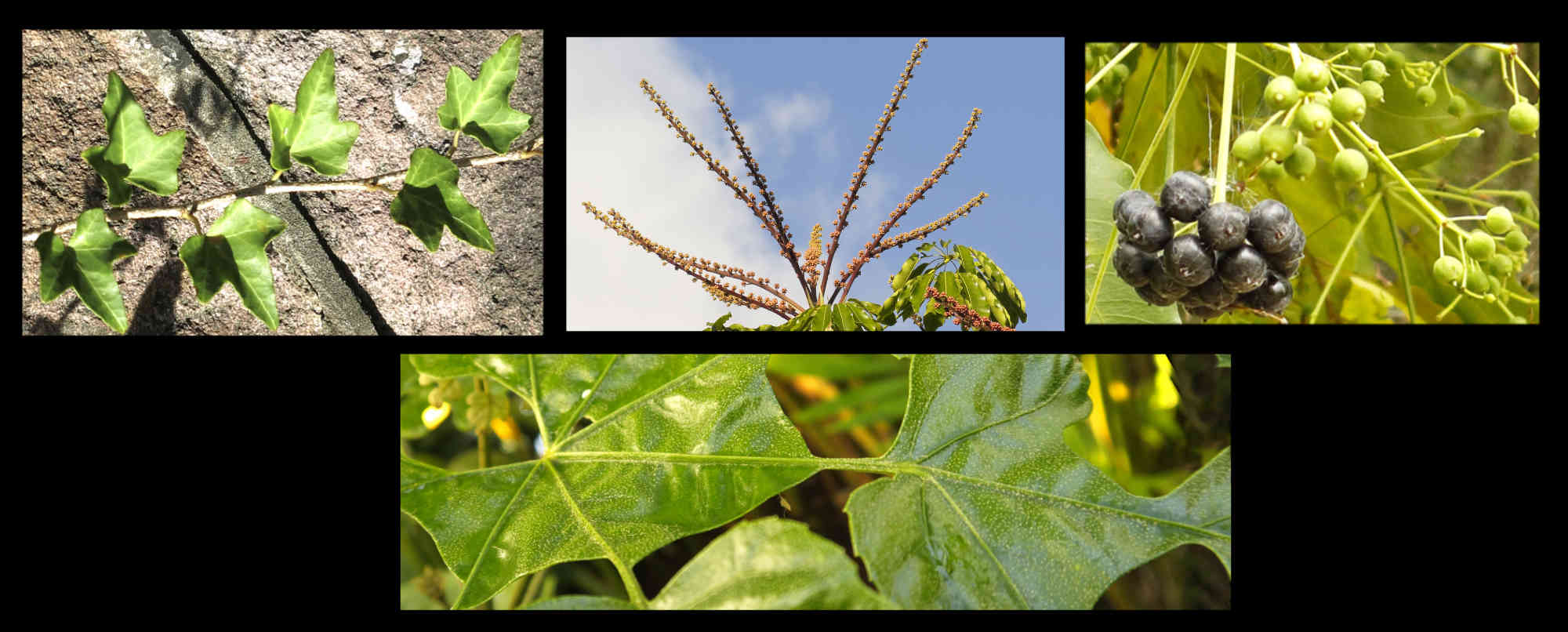Araliaceae.
Ginseng Family.
The Araliaceae is a very variable family and there is no one feature that defines it.
A combination of features is currently used including the mostly alternate leaves usually being compound,
the presence of prickles in some, umbel inflorescences, and the fruit mostly being berries or drupes.
These individual features also occur in many other families.
There is still a lot of work to be done before the classification is settled.
The number of genera recognised varies from 38 to 70 with 600 to 1625 species.
Over 400 species occur in Australia
At present they are divided into 4 groups or into subfamilies.
Subfamily Aralioideae contains many of the genera including Aralia, Fatsia, Hedera (ivy),
Polyscias, Schefflera (umbrella trees) and Trevesia.
They are mostly woody plants with a few herbs.
Woody plants are trees, shrubs or lianas that climb using twining stems or aerial roots.
Some are epiphytes or start as epiphytes before becoming shrubs or trees.
There may be simple, branched or stellate hairs on various parts and prickles are sometimes present.
The medium to large leaves are almost always alternate in a spiral and rarely opposite or whorled.
The majority are 1, 2 or 3 times pinnate or palmate and some are lobed with 2 or 3 divisions.
They can also be simple or trifoliate.
Leaves may be sessile or on short to long petioles whose bases may slightly sheath the stem.
When stipules are present they may be fused to the petiole or free of it.
Some have different juvenile and adult leaves.
Inflorescences are usually terminal but may be below a leaf axil (pseudolateral).
They can be a single flower, a simple or compound umbel, a panicle, spike or a dense cluster.
The flowers can be bisexual or uni-sexual and bracts and bracteoles may be present.
The calyx may be absent or consist of 5 (3 to many) small blunt or pointed sepals.
The 5 (3 to 18) petals are usually separate but may be joined at the tip or base.
Colours include white, cream, greenish, pink, red, yellow or purple.
There are 5 or 10 (3 to many) free stamens on fleshy filaments.
The dorsifixed anthers open inwards via longitudinal slits.
There may be a nectiferous disc.
The ovary, of 2 to 5 (many) fused carpels is almost always inferior but may be part inferior.
There are 1 to many locules with 1 (2) ovule in each.
There are usually as many (0 to 100) styles as there are carpels.
The styles may be free to totally fused and their swollen bases may form a stylopodium.
The stigmas may be on the style/s or a stylopodium.
The fruit are usually drupes or berries or occasionally a schizocarp.
The drupes may have 1 seed or occasionally split into segments or pyrenes (a seed enclosed in a hard endocarp).
The number of pyrenes is equal to the number of carpels.
J.F.


